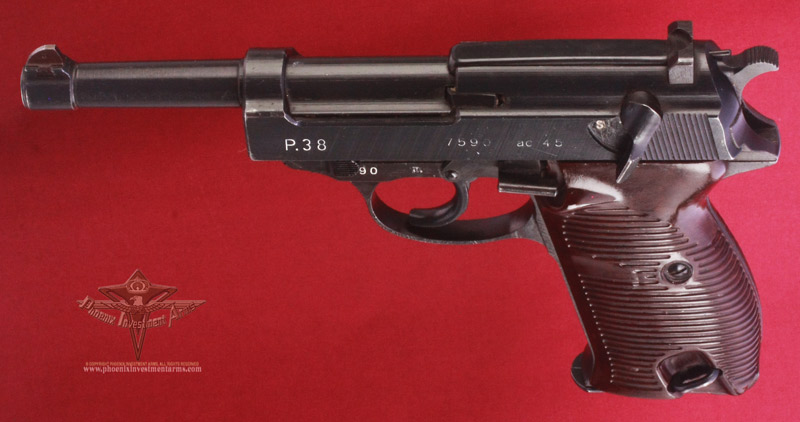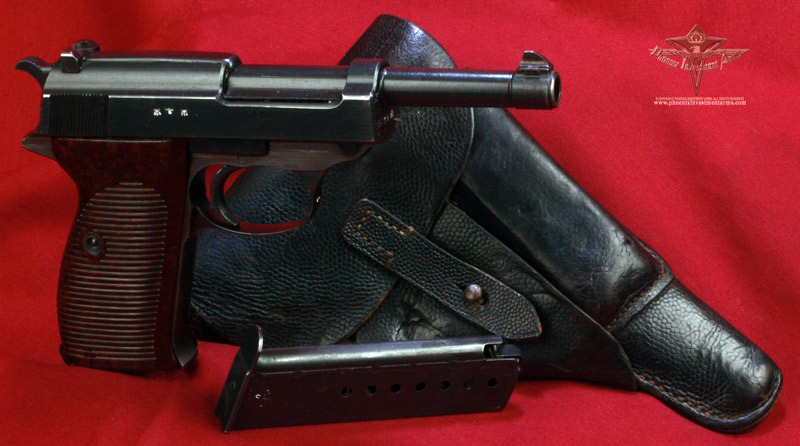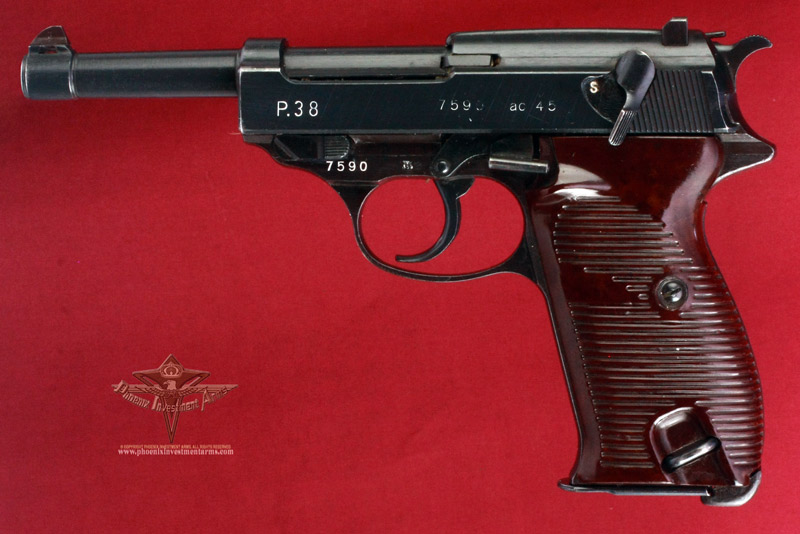Walther ac45 P38 LAYAWAY
PHOENIX INVESTMENT ARMS - PREMIUM COLLECTOR LUGERS
Genuine German Luger - Largest Variety of Lugers Offered
Home | Post WWI DWM | Erfurt Lugers | Mauser | Simson Suhl | Krieghoff | Vickers, Ltd | Swiss Bern | Other Guns|
Bottom of Page
|
|
| This is a Walther 1945 [end-of-war] 9mm P-38 holstered rig. Overall excellent condition speaks to the short time this gun was manufactured and when it was captured. (1934) |
|
|
|
NOTE: Photographs taken today with the high mega-pixel camera show more than we sometimes can see with the human eye. Magnified close-ups show us tool marks and natural surface conditions that one normally doesn't see in the ordinary handling of the weapon. Photographs are copyrighted, all rights reserved, any extraction, reproduction or display of gun pictures without the express consent of the Phoenix Investment Arms is strictly prohibited. Thank you for your cooperation. Please visit Legal (tabbed) for Conditions of Sale. |
|
The first designs submitted to the German Army featured a locked breech and a hidden hammer, but the Heer (German Army) requested that it be redesigned with an external hammer. The P38 concept was accepted by the German military in 1938 but production of actual prototype ("Test") pistols did not begin until late 1939. Walther began manufacture at their plant in Zella-Mehlis and produced three series of "Test" pistols, designated by a "0" prefix to the serial number. The third series pistols satisfactorily solved the previous problems for the Heer and mass production began in mid-1940, using Walther's military production identification code "480". After a few thousand pistols the Heer changed all codes from numbers to letters and Walther was given the "ac" code. |
|
|
|
|
The design is simple by German standards and incorporated many forward innovations. The Walther P38 is a 9 mm semi-automatic pistol that was developed by Walther arms as the service pistol of the Wehrmacht at the beginning of World War II. It was intended to replace the costly Luger P08, the production of which was scheduled to end in 1942. |
|
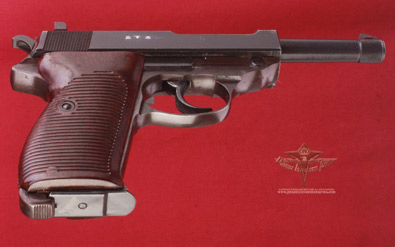 |
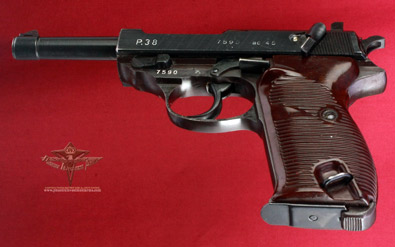 |
|
The P38 was the first locked-breech pistol to use a double-action/single-action (DA/SA) trigger (the earlier double-action PPK was an unlocked blow back design, but the more powerful 9x19mm Parabellum round used in the P38 mandated a locked breech design). The shooter could chamber a round, use the safety-decocking lever to safely lower the hammer without firing the round, and carry the weapon loaded. |
|
 |
|
|
This lever can stay down, keeping the pistol "on safe" or be immediately returned to the straight position, keeping the weapon safely "ready" with a double-action trigger pull for the first shot. Pulling the trigger cocks the hammer before firing the first shot with double-action operation. |
|
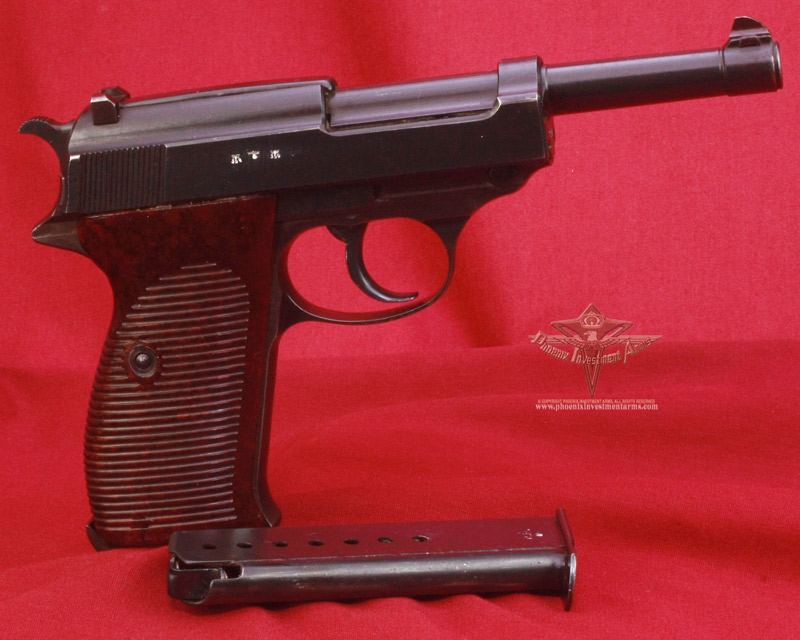 |
|
The firing mechanism extracts and ejects the first spent round, cocks the hammer, and chambers a fresh round for single-action operation with each subsequent shot - all features found in many modern day handguns. Besides a DA/SA trigger design similar to that of the earlier Walther PPKs the P38 featured a visible and tactile loaded chamber indicator in the form of a metal rod that protrudes out of the top rear end of the slide when a round is present in the chamber. |
|
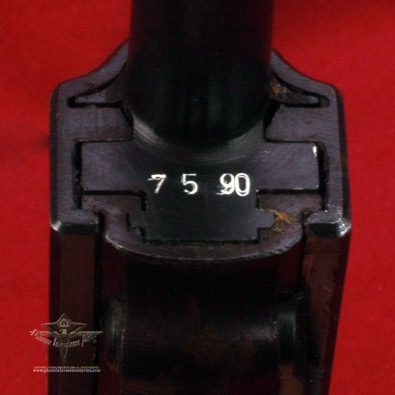 |
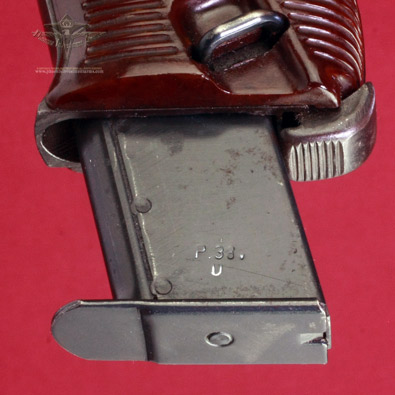 |
|
Here the serial number is seen on the barrel block. The magazine release is on the bottom of the hand grip; this was one of the less than desired features as it took longer to reload the magazine than the push-button types. This is an all-matching P-38. the magazines in the very early P-38's were numbered |
|
Designed in 1938 The Walther P-38 came to weigh 800 g (1 lb. 12 oz.) with a length of 216mm (8.5 in) and the barrel measuring 125mm (4.9 in) and firing the standard 9mmX19mm cartridge. It is described as a short recoil, locked breech action producing a muzzle velocity of 365m/s (1,200 ft/s) with the fixed sights set for 50m (55yd) It loads from an eight round single-stack magazine and fires both single action and double action..
|
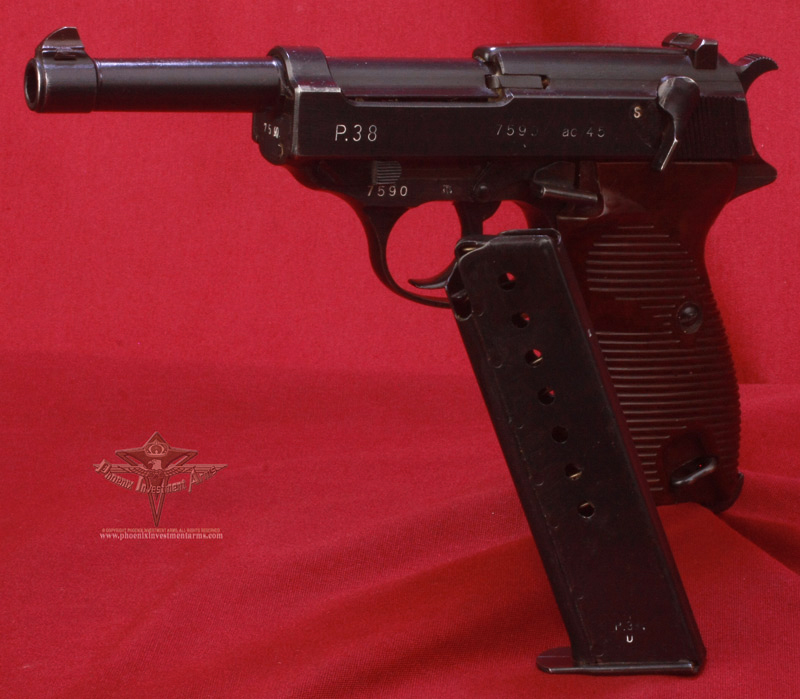 |
|
| The magazine was the metal wrapped with the crimp and spot welded. It was marked on the side with the designation P38. The spring was the "Z" type and it was a very sturdy magazine difficult to twist or dents. Magazines prior to December-January 1941/42 were numbered to the gun. Post that period they were just stamped P-38. | |
 |
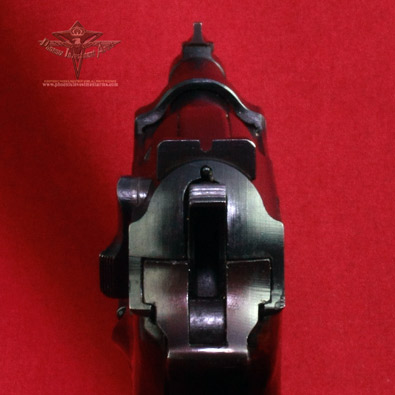 |
Left Above: The front sight was the standard blade type with the zero set to 50 meters. Right Above: Just above the rear exposed hammer is the small pin that rests on the chamber and it extended when load to tell the shooter both visible and tactilely that a round was chambered. |
|
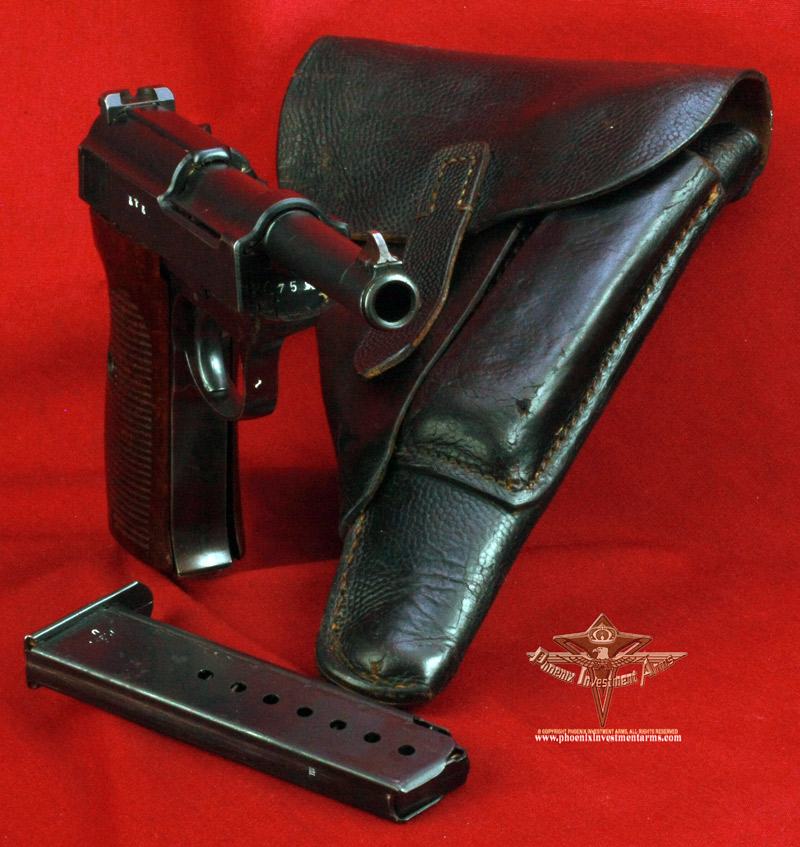 |
|
The P38 was the first pistol to combine a locked breech with a DA/SA trigger, whereby the hammer could rest with a round in the chamber, and the first shot could be fired in double-action mode, with subsequent shots fired in the single-action mode. This design has been copied numerous times up to and including today for most modern pistols, until the advent of the striker-fired pistol. |
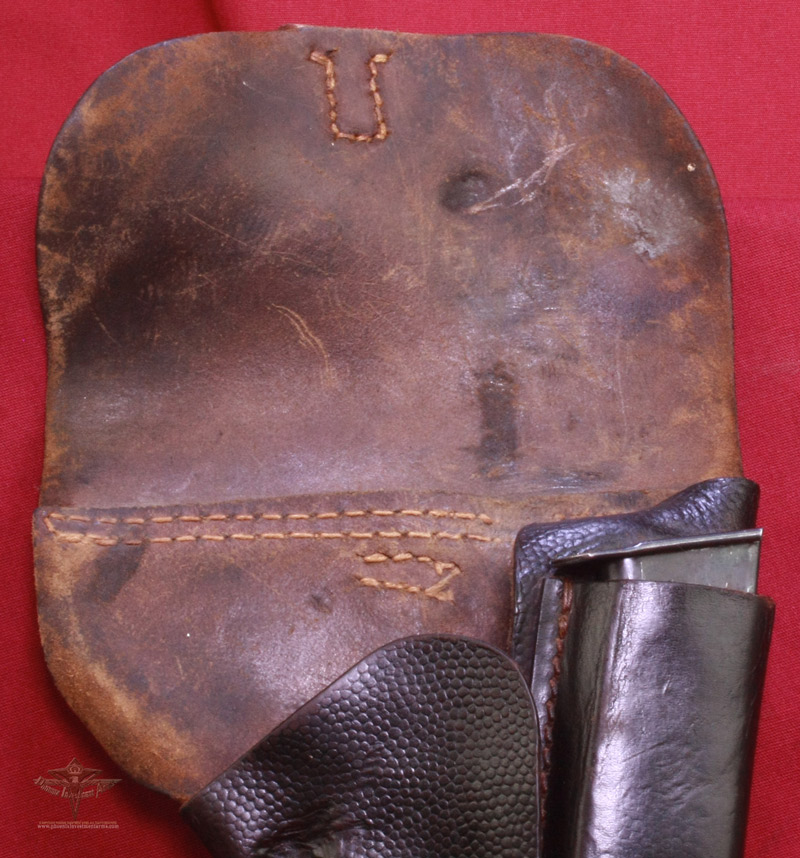 |
|
|
Coming at the end of the war cow hide was in short supply so pig skin was used for a multitude of purposes including late model holster. Here the wrap around light weight holster with the front magazine pouch was the last design of holster before the end of WWII.
| |
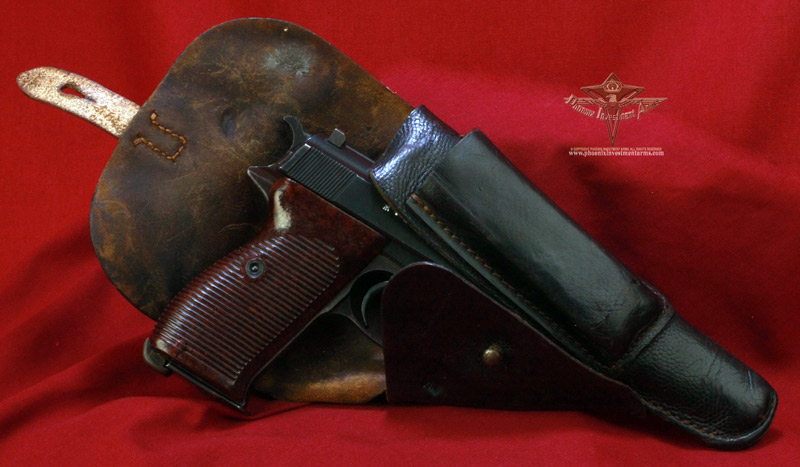 |
|
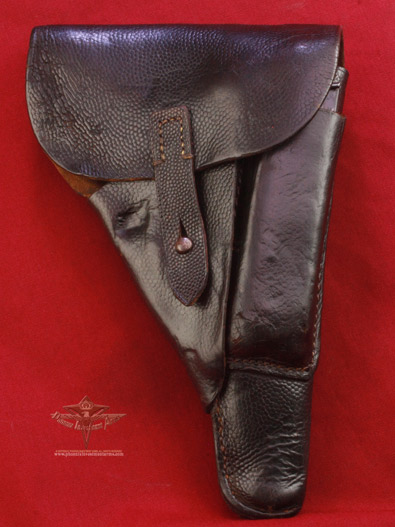 |
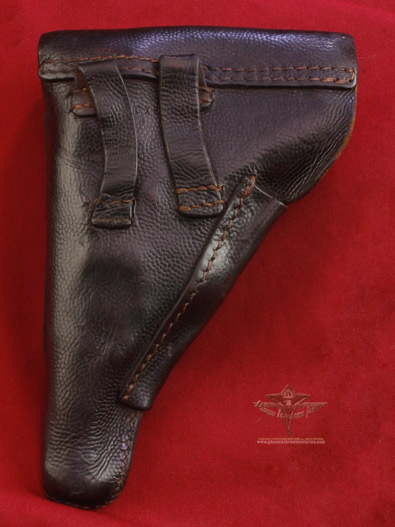 |
|
Designed for most protection with the least materials the 1945 version of the P38 holster offered the two belt loops and break away model. Stitching is still very much intact. |
|
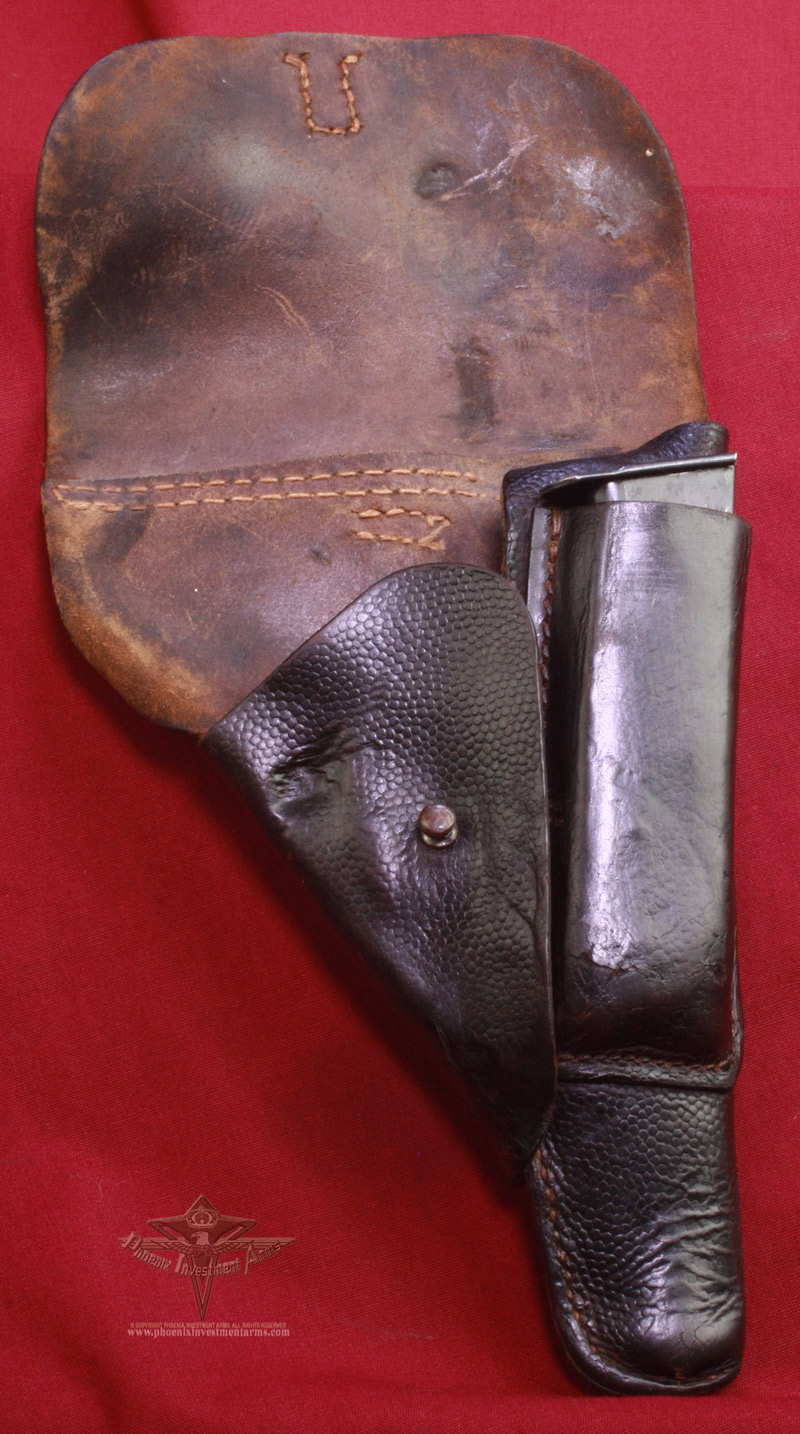 |
|
No proof marks were on these end of the war models but this one is in excellent shape and provided the Walther made pistol with all semblance of adequacy. |
|
The P38 is also one of the first service pistols to employ a loaded-chamber indicator, a small piece of rod that protrudes out of the top toward the rear of the slide when a round is in the chamber. Instead of using a link like a 1911 to unlock the barrel and allow it to drop out of battery during the cycling of the slide, the P38 employs a wedge-shaped falling block to keep the slide and barrel locked together until enough pressure has decayed to allow the slide to reciprocate safely. |
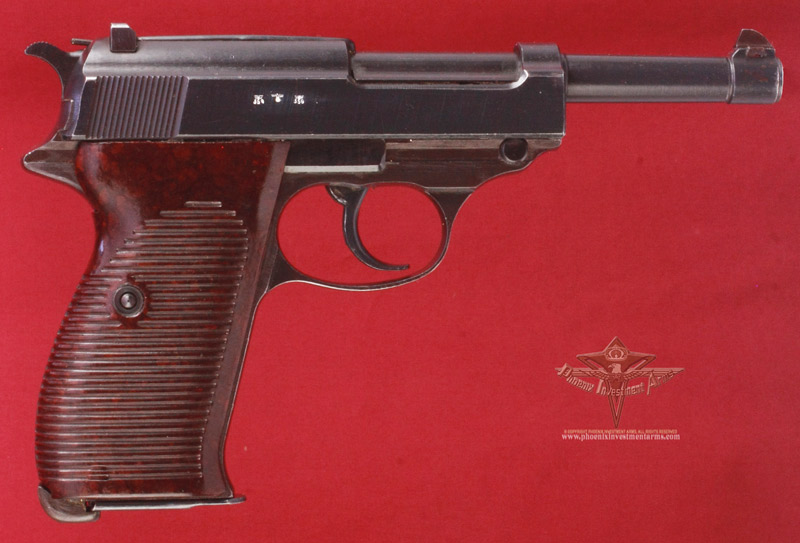 |
|
|
This is a nice high-polish Walther ac45. It is a second variation pistol with high-polish blue but no 'ac' proof on the trigger guards. It is all original and matching. All the major parts are E/359 proofed, as they should be. Finish rates at about 95% with minor edge wear and some patina on the front strap. E/359 proofed grips and mag, as well. Excellent bore. |
|
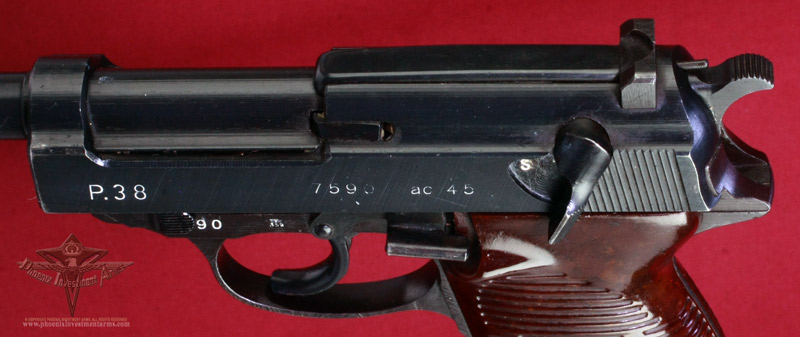 |
|
|
Above the hammer in the upper right corner of this picture is a small rod protrusion (chamber indicator) that is telling the shooter both visually and tactilely that a round is in the chamber and the gun is ready to shoot. |
|
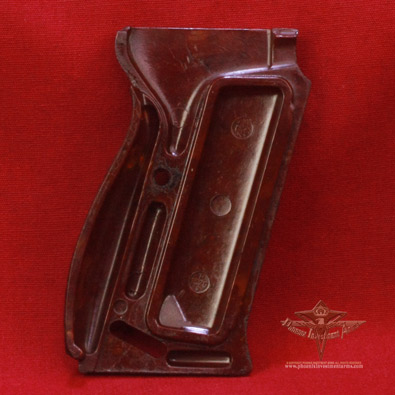 |
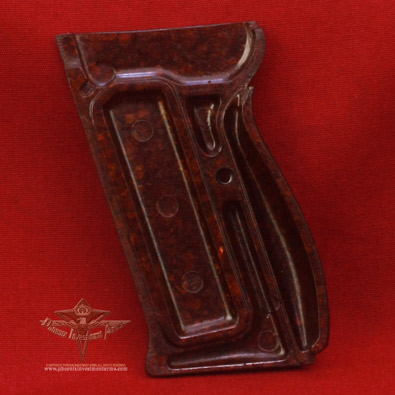 |
|
Initial production P38 pistols were fitted with walnut grips, but these were later supplanted by Bakelite grips. These grips are in excellent condition as seen above. |
|
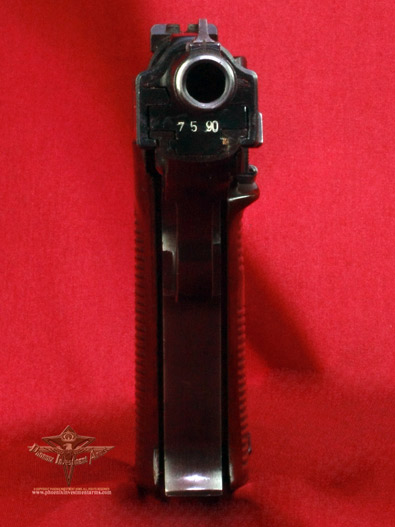 |
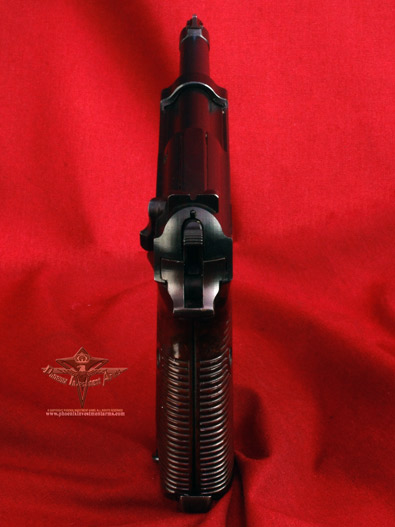 |
While production of the Walther P-38 by the Heeres-waffenamt began in 1939 all the P-38's before June 1941 have the commercial grade polished blue finish. Without exhibiting the late commercial proofing the finish on this end-of-war gun is clearly superior to the other finishes we have observed on the ac44/45's indicating this must have been made from the commercial highly polished parts. This finish is minty. |
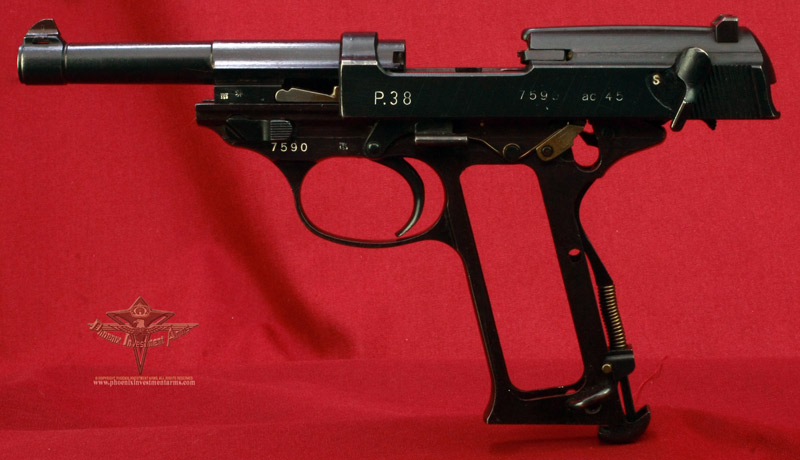 |
The moving-barrel design mechanism operates by use of a wedge-shaped falling locking block underneath the breech. When the pistol is fired both the barrel and slide recoil for a short distance together, where the locking block drives down, disengaging the slide and arresting further rearward movement of the barrel. The slide however continues its rearward movement on the frame, ejecting the spent case and cocking the hammer before reaching the end of travel. |
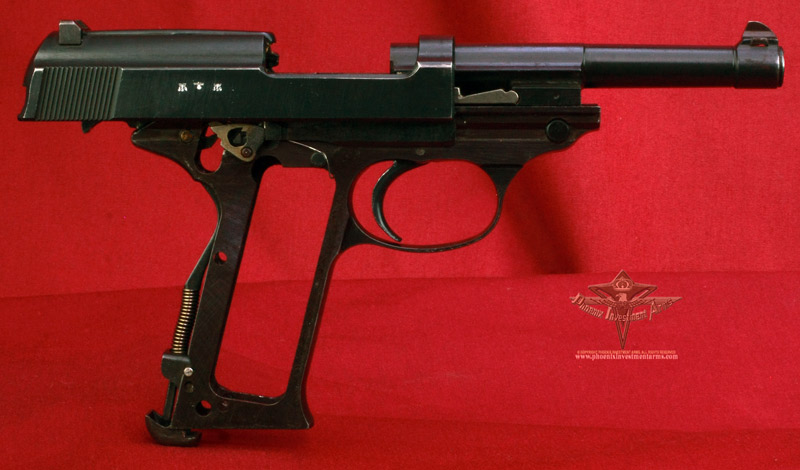 |
|
Two return springs located on either side of the frame and below the slide, having been compressed by the slide's rearward movement, drive the slide forward, stripping a new round from the magazine, driving it into the breech and, in the process, re-engaging the barrel; ending its return travel with a fresh round chambered, hammer cocked and ready to repeat the process. The falling locking block design provides good accuracy due to the in-line travel of the barrel and slide. |
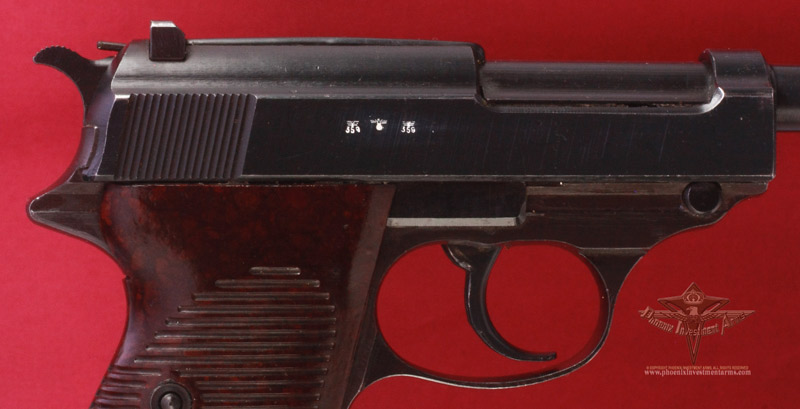 |
|
By 1945 the number of inspections had dwindled to the most essential. Here we can see the Walther proof Eagle 359 and the German Waffenamt proof. No markings on the right of the frame or proofs other than those above. |
 |
| It is entirely subjective to give any firearm a rating of excellent or fine, just as it is to declare it xx% blued or strawed. Few collectible weapons are out of the box new and these are premium priced. Bluing percentages is like Beauty, in the eye of the beholder. We strive to provide pictures so you can judge for yourself if the gun meets your criteria. Any questions or request for additional purchases email to josef@phoenixinvestmentarms.com. This firearm is eligible for transfer to C&R permit holder, even in California. We are registered with CA DOJ for firearms shipment. |
While Walther’s P38 may have lacked the “fineness” and graceful lines of its predecessor the P08 Parabellum, nor the legendary thump of the .45-caliber 1911, it marks the starting point of the modern day service pistol. Tough and raw-boned, it doesn’t lure you to it with a perfect single-action trigger release. But out in the mud and dirt-soaked world of wartime combat, it certainly earned its place as one of the great pistols of our time and well worth shooting or collecting. |
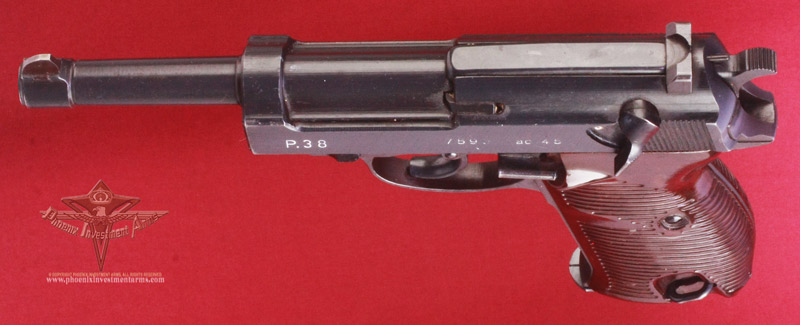 |
|
This Walther made 1945 version Pistole 38 is in very good - excellent condition and offered with a period holster, and a 2nd Magazine for $2,695.00 [SOLD]. This Parabellum show minimal honest holster wear and a strong shiny barrel. This gun may be sold before being posted as such on the internet. We reserve the right to sell any internet offering to a direct sale and no not warrant the availability of any firearm that does not have a physical deposit. This gun may be withdrawn without notice for in-store sale. |
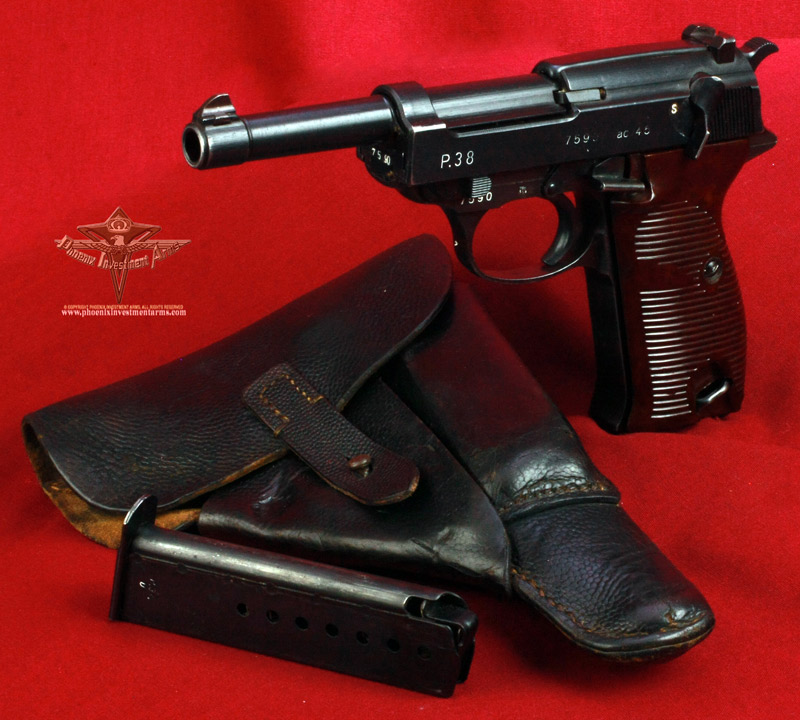 |
Home | New Additions | 1900-06 | WWI Imperial | Carbines | Artillery | Imperial Navy | Police Models | Archived Lugers | Accessories
Sell Your Gun | Notices | Good Info (C&R) | Ordering | Contact Us | Gun Shows | Legal Stuff | Testimonials | Notices | Holsters | Books
Top of Page
LAYAWAYS: Sometimes our "significant other" doesn't understand the beauty, craftsmanship and investment potential of one of these investor grade weapons. In these circumstances where discretion becomes the better part of valor we will accept layaways of up to one year with at least 20% down and some activity occurring monthly to insure that after one year the sale is completed. Cancellations of layaways forfeit 33% if done within two months, otherwise 100%. You can transfer a layaway to a consignment sale at any time. See "Legal" for exact terms. |
|
3 Day Return Policy We honor a three day return policy. We will answer any questions, send you any pictures, as detailed as you want, to insure that what we are showing you is what you want to see, before you buy it. See Legal. |
||
|
